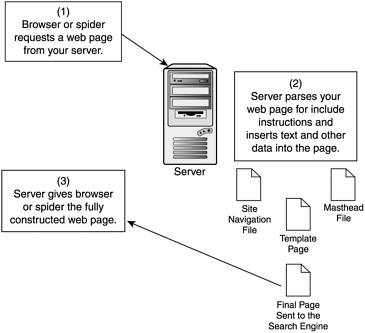Server-Side Includes (SSI)
| A Server-Side Include (SSI) is a type of HTML comment that instructs a web server to dynamically generate elements of a web page before it sends the web page to a browser or a search engine spider. The key item to remember is that a web server constructs a web page before it sends the web page to the search engines. Therefore, any page built with SSIs must contain the most important elements of a search engine “friendly page: keyword-rich text and a navigation scheme that the search engine spiders can follow. Figure 3.17 outlines how web pages with SSI comments are presented to the search engines. Figure 3.17. Web pages constructed using SSIs are created in the web server first, then presented to the search engines. As long as fully constructed pages are optimized, they can appear at the top of search engine results. Web designers can place any type of element inside an include file. The most common items to use as include files are mastheads, navigation elements, and content. To make SSI web pages search engine friendly, the fully constructed pages should contain keyword-rich text in the title tags, meta tags, visible body text, and alternative text. If a web developer inserts a navigation scheme through SSI, make sure the navigation scheme is spider friendly. When in doubt, create two forms of navigation: one for your target audience and one that the search engine spiders can follow. A set of text links at the bottom of every page can increase a site's search engine visibility. Web pages that use SSIs generally have a file extension of .shml or .shtm. For example, if the fictional TranquiliTeas site used a SSI as part of its design, the oolong tea page URL would look like the following: www.tranquiliteasorganic.com/oolongtea.shtml Warning
Because this URL contains none of the stop characters that a typical dynamic URL contains (?, &, $, =, +, or %), the URL is search engine friendly. |
EAN: 2147483647
Pages: 111
If you may any questions please contact us: flylib@qtcs.net
